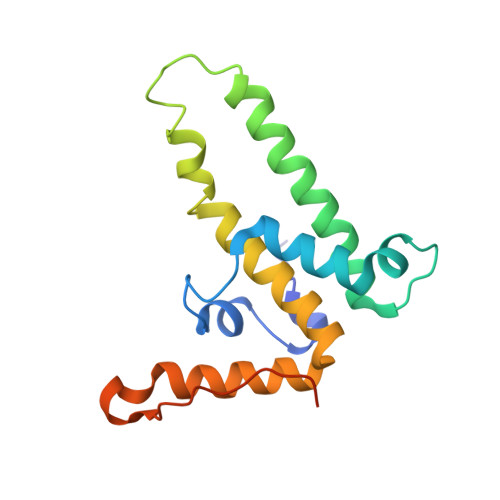Thermodynamic Origins of Protein Folding, Allostery and Capsid Formation in the Human Hepatitis B Virus Core Protein
Alexander, C.G., Juergens, M.C., Shepherd, D.A., Freund, S., Ashcroft, A.E., Ferguson, N.(2013) Proc Natl Acad Sci U S A 110: E2782
- PubMed: 23824290
- DOI: https://doi.org/10.1073/pnas.1308846110
- Primary Citation of Related Structures:
4BMG - PubMed Abstract:
HBc, the capsid-forming "core protein" of human hepatitis B virus (HBV), is a multidomain, α-helical homodimer that aggressively forms human HBV capsids. Structural plasticity has been proposed to be important to the myriad functions HBc mediates during viral replication. Here, we report detailed thermodynamic analyses of the folding of the dimeric HBc protomer under conditions that prevented capsid formation. Central to our success was the use of ion mobility spectrometry-mass spectrometry and microscale thermophoresis, which allowed folding mechanisms to be characterized using just micrograms of protein. HBc folds in a three-state transition with a stable, dimeric, α-helical intermediate. Extensive protein engineering showed thermodynamic linkage between different structural domains. Unusual effects associated with mutating some residues suggest structural strain, arising from frustrated contacts, is present in the native dimer. We found evidence of structural gatekeepers that, when mutated, alleviated native strain and prevented (or significantly attenuated) capsid formation by tuning the population of alternative native conformations. This strain is likely an evolved feature that helps HBc access the different structures associated with its diverse essential functions. The subtle balance between native and strained contacts may provide the means to tune conformational properties of HBc by molecular interactions or mutations, thereby conferring allosteric regulation of structure and function. The ability to trap HBc conformers thermodynamically by mutation, and thereby ablate HBV capsid formation, provides proof of principle for designing antivirals that elicit similar effects.
- School of Medicine and Medical Science, University College Dublin, Dublin 4, Ireland.
Organizational Affiliation:
















